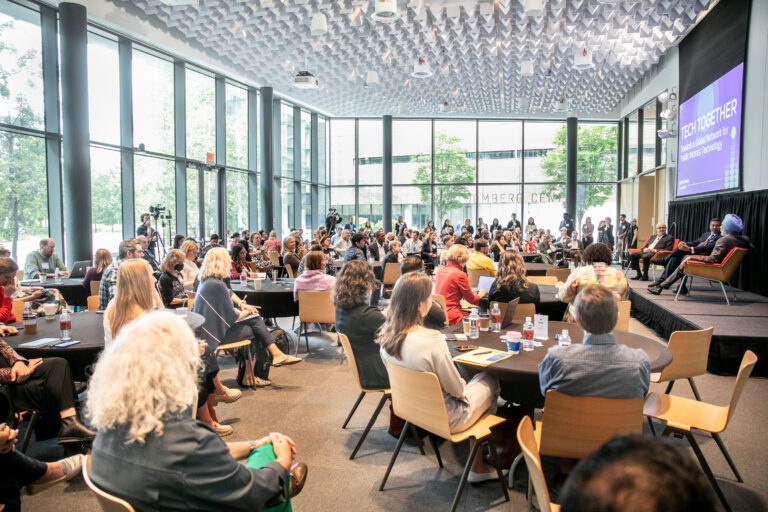
Our series Building an Equitable Innovation Economy asks how we might build innovative capacity that can bring more people into high-growth industries. We explore three pillars that set a stage where innovation can emerge: community-driven innovation, sustainable financing of lifelong skilling, and access to empowering social connections. How can we approach each of these leverage points – individually, and in coordination – to create a more inclusive and equitable innovation economy?
We define social infrastructure as the relationships and communities that shape the way people connect. The prevalence of networking events, internship opportunities and other rituals of our contemporary careers points to the unspoken truth – social connections lead to opportunities. But there’s a caveat: the social connections you have, and the social connections you are able to make, are often constrained by access.
An MIT report found that when networks are limited to certain regions or within certain communities, “who you know” can constrain who you might meet – and the opportunities that might emerge. It shows that the more “open” and “diverse” an individual’s social network, the greater their income was on average. In fact, incomes varied less for different levels of education than it did for the diversity of an individual’s networks. The lack of social capital can be particularly meaningful as it impacts economic mobility for low-income communities, first-generation migrants, and people of color.
While knowledge and skills are vital components of innovation capacity, we also need to address the world as it is. That means broadening access to mentorships, advisors, peers, and capital in ways that open doors for innovation and upward mobility. Forging new connections beyond these inherited networks requires intentionality in program design. It’s not enough simply to meet people from beyond your network, but to build meaningful relationships based on mutual care.
It’s worth noting that it’s not unusual for social infrastructure to be engineered, with prime examples being alumni networks or fellowship cohorts. How might we (re)design these programs with inclusivity and diversity as our guiding star?
To explore such alternatives, we’re digging into existing inequities around who does or does not participate in social infrastructures. How do we create more opportunities, for more people, to build those important connections? We believe that fusing meaningful relationship development alongside skills development can create opportunities for people to become part of the innovation economy.
CO-OP Cohorts Create New Paths to Mentorship
CO-OP offers digital apprenticeships for diverse, low-income, and first-generation grads from the City University of New York, California State Universities, and other urban public colleges. Their program design addresses the challenge facing recent unemployed and underemployed college graduates: skills simply weren’t enough. For them, the missing piece of the puzzle was “connections, casual favors, timely referrals.” That is, social infrastructure, which “travel[s] quickly and organically across strong and weak social ties, but rarely across racial or economic lines.”
CO-OP’s apprenticeships connect a cohort of Black, Latinx, low-income, and first-generation college graduates to mentors and coaches who work in the tech and communications companies relevant to their skills and training. CO-OP has run more than 100 cohorts, creating 2,000 alumni. Of those, four-out-of-five moved from underemployment within a year, tripling their pre-program average incomes and averaging salaries of $60,000 three years after participating in the program. The success of CO-OP’s model suggests a promising path forward for the integration of skills- and relationship-building.
New Growth Innovation Network Builds Power in Knowledge-Sharing
As we’ve discussed before, “innovation economies” often cluster around technology focused hubs, leading to a concentration of skills, talent, and capital. For communities far from those hubs, this can create challenging conditions for local prosperity, even when conditions are ripe for opportunity. Part of the social infrastructure we’re focused on is the exchange of knowledge and networks between economic development leaders dedicated to inclusive growth strategies in their neighborhoods and regions.
The New Growth Innovation Network (NGIN) focuses on structural inequalities that limit economic growth and prosperity for people of color, women, and neglected geographies. NGIN brings together practitioners, subject matter experts and partners, including leaders from small-town and rural communities. Through convenings, round tables and knowledge exchange, the NGIN is building a field open to participation from those left out of “the innovation economy,” and doing so with an emphasis on building accessible on-ramps to these economies for remote communities and for people who may otherwise be excluded.
ICA Fund
Women entrepreneurs and entrepreneurs of color are often shut out of opportunities to propel their businesses forward due to lack of access to growth capital, business connections, systems that provide support and development (and some of which actively seek to exclude), and the social capital that are proven key drivers of success. ICA Fund seeks to address this issue by providing “coaching, connections, and capital” for business owners of color in the Bay Area, with the broader aim of closing racial and gender wealth gaps.
To that end, they provide an ecosystem of support to fill the gap for small businesses that are positioned for growth but need advising and capital to do it. ICA has developed an entrepreneurial infrastructure that serves growth-oriented companies in the Bay Area and developed accelerator programs and investment products, combined with expert advising and right-sized financing to help grow small businesses.
Cultivating Innovative Capacity
This focus on social infrastructure is one piece of our interconnected, multidimensional approach to the challenges of expanding participation in today’s innovation economy. Innovative capacity emerges from many factors. We’re looking at approaches that build meaningful relationships and networks that move beyond serendipity to create thoughtful opportunities for connections between people and communities. We’re asking how we can best develop mentorship models and knowledge networks that transcend boundaries of race, gender, class, and geography.





